What Is an ADU & Why Build One
An accessory dwelling unit, commonly called an ADU, is a secondary housing unit on a single-family residential lot. These smaller homes go by various names: granny flats, in-law suites, backyard cottages, or casitas. An ADU has its own kitchen, bathroom, and living space, making it a complete, independent residence.
Homeowners build ADUs for many reasons. Some want housing for aging parents who need to stay close but maintain independence. Others create rental income to help with mortgage payments or save for retirement. ADUs can serve as home offices, art studios, or guest quarters. As housing costs rise in many areas, ADUs offer a way to increase density without changing neighborhood character.
The investment in an ADU often increases property value. Buyers pay more for homes with rental income or flexible living spaces. In some markets, the rental income can cover the construction costs within several years. Even if you don’t rent it out immediately, having the option adds value when you sell.
Types of ADUs You Can Build
Detached ADUs are separate structures in your backyard. These offer the most privacy since occupants don’t share walls with the main house. They work well when you have sufficient yard space and want clear separation between households. Detached units can be custom-built or purchased as prefabricated structures that get assembled on-site.
Attached ADUs connect to the main house but have a separate entrance. These cost less than detached units since they share at least one wall and can tap into existing utilities more easily. An attached ADU might extend from the side or back of your home. Some homeowners convert garages into attached ADUs, keeping the garage door for aesthetics while creating living space inside.
Internal ADUs are created within the existing home, typically in a basement or by converting unused space. These are usually the least expensive option since the structure already exists. However, they require meeting code requirements for ceiling height, egress windows, and ventilation. Internal conversions work best when you have underutilized space that meets basic size and access requirements.
Zoning & Legal Requirements
Local zoning laws determine if you can build an ADU and what restrictions apply. Some cities actively encourage ADUs by streamlining the approval process and reducing fees. Others have strict size limits, setback requirements, or prohibit ADUs entirely in certain zones. Research your local regulations before making plans.
Common restrictions include maximum square footage (often 800-1,200 square feet), height limits, and requirements about parking spaces. Some areas mandate that the property owner lives on-site, either in the main house or the ADU. Others limit ADUs to certain lot sizes or require a minimum lot size.
Building permits are required for ADU construction. The permit process includes submitting architectural plans, site plans, and engineering documents. Inspections happen at various construction stages to verify code compliance. Some jurisdictions fast-track ADU permits to encourage their construction, while others treat them like any other building project.
Design Considerations for Your ADU
Size matters when designing an ADU. While you want enough space for comfortable living, bigger isn’t always better. Construction costs rise with square footage, and some zoning codes limit ADU size to a percentage of the main house. A well-designed 500-square-foot unit can feel spacious if laid out thoughtfully.
Consider who will use the space. An ADU for aging parents needs different features than a rental unit for college students. Aging-in-place designs include zero-step entries, wider doorways for wheelchairs, grab bars in bathrooms, and single-floor living. Rental units should focus on durability and low maintenance.
Natural light makes small spaces feel larger. Include windows on multiple walls if possible. High ceilings also create an open feeling. Open floor plans that combine kitchen, dining, and living areas maximize usable space. Built-in storage and multi-function furniture help reduce clutter in a compact home.
Utility Connections & Systems
ADUs need water, sewer, electrical, and gas connections. How you handle utilities affects construction costs significantly. Tapping into existing lines from the main house is usually cheaper than running new connections from the street. However, you may need to upgrade the main house’s systems to handle the additional load.
Separate utility meters for the ADU allow you to track usage if you’re renting it out. Some areas require separate meters, while others allow you to share. Consider energy efficiency from the start. Good insulation, efficient windows, and modern HVAC systems reduce operating costs and increase tenant comfort.
Internet and phone service are expected in modern housing. Plan for adequate outlets and consider running ethernet cables during construction. Adding these later means cutting into finished walls. Smart home features like programmable thermostats and keyless entry appeal to renters and make property management easier.
Construction Methods & Costs
Traditional stick-built construction offers the most customization but takes longer and may cost more. Builders construct the ADU on-site using standard framing techniques. This method works well for challenging lots or when you want a design that matches your main house exactly.
Prefabricated or modular ADUs arrive largely complete and get installed in days rather than months. These units are built in factories under controlled conditions, which can mean better quality control. However, your design options may be limited, and you still need foundation work and utility connections done on-site.
Costs vary widely based on size, finishes, location, and site conditions. Budget between $150 to $400 per square foot for most ADUs. A basic 600-square-foot unit might cost $90,000, while a high-end 800-square-foot detached ADU could exceed $300,000. Site preparation, utility connections, and permits add to these costs.
Financing Your ADU Project
Several financing options exist for ADU construction. Cash payment avoids interest but ties up funds you might need elsewhere. Home equity loans or lines of credit typically offer lower interest rates than personal loans since your home secures them. Some lenders offer specific ADU construction loans.
Cash-out refinancing replaces your current mortgage with a larger one, giving you funds for construction. This works well when interest rates are favorable. FannieMae’s HomeStyle Renovation loan allows you to include renovation costs in your mortgage. Check with multiple lenders since ADU loan products and requirements vary.
Some cities and states offer grants or low-interest loans to encourage ADU construction, particularly for affordable housing. Research local programs that might help with financing. Remember to factor in the time value of money if you plan to rent the ADU. Rental income can help pay back loans faster.
Finding the Right Builder
Not all contractors have experience with ADUs. Look for builders who have completed multiple ADU projects. They’ll know local codes, common challenges, and cost-effective solutions. Ask to see their portfolio and talk to previous clients about their experiences.
Get detailed bids from at least three contractors. Bids should break down costs for materials, labor, permits, and site work. The lowest bid isn’t always the best choice. Consider the contractor’s reputation, communication style, and timeline estimates along with price.
Verify the contractor has proper licensing and insurance. ADU construction requires the same credentials as building a main house. Check references carefully. Ask about how the contractor handled problems, stayed on schedule, and communicated during the project.
Maximizing Your Investment
Think long-term when making design decisions. Trends change, but quality construction and timeless design hold value. Choose durable materials that need little maintenance. Neutral colors appeal to more possible renters or buyers than bold personal choices.
If renting, research local rental rates for comparable units. Set your rent competitively while ensuring it covers your costs and provides return on investment. Screen tenants carefully and create clear lease agreements. Some owners manage rentals themselves, while others hire property managers.
Keep records of all construction documents, permits, and warranties. These prove the ADU was built legally and help with future sales or refinancing. Document your costs carefully for tax purposes. Some ADU expenses may be deductible, particularly if you rent the unit.

